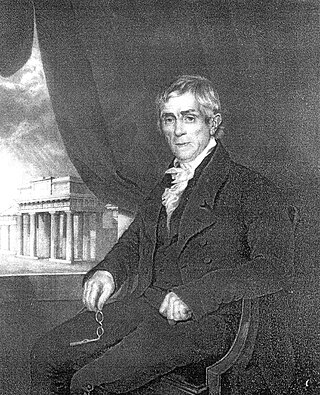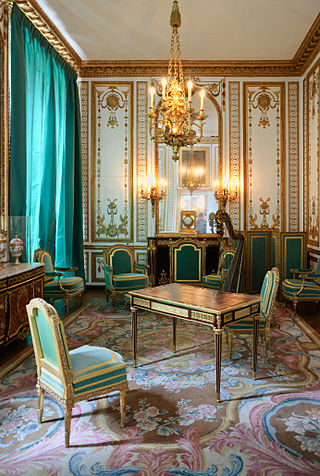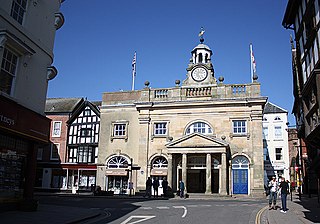This article needs additional citations for verification .(April 2019) |
| |||
|---|---|---|---|
| Buildings and structures +... |
The year 1775 in architecture involved some significant events.
This article needs additional citations for verification .(April 2019) |
| |||
|---|---|---|---|
| Buildings and structures +... |
The year 1775 in architecture involved some significant events.


Blois is a commune and the capital city of Loir-et-Cher department, in Centre-Val de Loire, France, on the banks of the lower Loire river between Orléans and Tours.

Sir William Chambers was a Swedish-Scottish architect, based in London. Among his best-known works are Somerset House, and the pagoda at Kew. Chambers was a founder member of the Royal Academy.

In architecture, a folly is a building constructed primarily for decoration, but suggesting through its appearance some other purpose, or of such extravagant appearance that it transcends the range of usual garden buildings.
This is a timeline of architecture, indexing the individual year in architecture pages. Notable events in architecture and related disciplines including structural engineering, landscape architecture, and city planning. One significant architectural achievement is listed for each year.
The year 1900 in architecture involved some significant events.
The year 1849 in architecture involved some significant events.
The year 1865 in architecture involved some significant architectural events and new buildings.
The year 1782 in architecture involved some significant events.

The year 1754 in architecture involved some significant events.

The Monnaie de Paris is a government-owned institution responsible for producing France's coins. Founded in AD 864 with the Edict of Pistres, it is the oldest continuously running minting institution and one of the oldest extant companies in the world.

Thomas Harrison was an English architect and bridge engineer who trained in Rome, where he studied classical architecture. Returning to England, he won the competition in 1782 for the design of Skerton Bridge in Lancaster. After moving to Lancaster he worked on local buildings, received commissions for further bridges, and designed country houses in Scotland. In 1786 Harrison was asked to design new buildings within the grounds of Lancaster and Chester castles, projects that occupied him, together with other works, until 1815. On both sites he created accommodation for prisoners, law courts, and a shire hall, while working on various other public buildings, gentlemen's clubs, churches, houses, and monuments elsewhere. His final major commission was for the design of Grosvenor Bridge in Chester.
The year 1827 in architecture involved some significant architectural events and new buildings.
The year 1758 in architecture involved some significant events.
The year 1770 in architecture involved some significant events.
The year 1790 in architecture involved some significant architectural events and new buildings.
The year 1767 in architecture involved some significant events.

Louis XVI style, also called Louis Seize, is a style of architecture, furniture, decoration and art which developed in France during the 19-year reign of Louis XVI (1774–1792), just before the French Revolution. It saw the final phase of the Baroque style as well as the birth of French Neoclassicism. The style was a reaction against the elaborate ornament of the preceding Baroque period. It was inspired in part by the discoveries of Ancient Roman paintings, sculpture and architecture in Herculaneum and Pompeii. Its features included the straight column, the simplicity of the post-and-lintel, the architrave of the Greek temple. It also expressed the Rousseau-inspired values of returning to nature and the view of nature as an idealized and wild but still orderly and inherently worthy model for the arts to follow.

The Hôtel des Monnaies is an 18th-century building located at 11 Quai de Conti in the 6th arrondissement of Paris, which has housed the Monnaie de Paris since its construction. It is considered a prime example of pre-Revolutionary French Neoclassical architecture.

Jacques Denis Antoine was a French architect, whose most notable masterwork is the Hôtel des Monnaies in Paris, which gained him entrance to the Académie royale d'architecture in 1776. He is also known for his work on private residences such as the Château of Buisson de May in Normandy, built from 1781 to 1783. Most of his works are in the Neoclassical architectural style.

William Baker of Audlem (1705–1771) was an architect, surveyor and building contractor, working in Shropshire and the adjacent counties in the middle years of the 18th century.